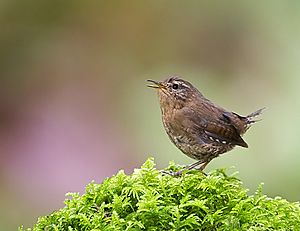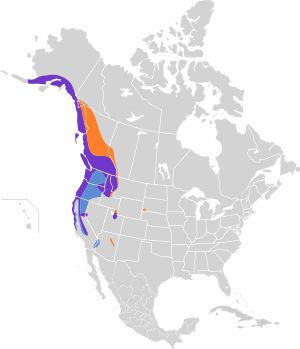Pacific wren facts for kids
Quick facts for kids Pacific wren |
|
|---|---|
 |
|
| Conservation status | |
| Scientific classification | |
| Genus: |
Troglodytes
|
| Species: |
pacificus
|
 |
|
| Synonyms | |
|
Nannus pacificus |
|
The Pacific wren (Troglodytes pacificus) is a tiny bird found in North America. It belongs to the wren family, which mostly lives in the Americas. This small bird was once thought to be the same species as the winter wren (found in eastern North America) and the Eurasian wren (found in Europe and Asia).
Pacific wrens live along the Pacific coast, from Alaska down to California. You can also find them inland in places like Wyoming and South Dakota. In winter, many Pacific wrens travel to warmer parts of the western United States and Canada.
Its scientific name, Troglodytes, comes from ancient Greek words. It means "cave-dweller." This name fits because the wren often hides in small holes or cracks. It does this when hunting for insects or when it needs a safe place to sleep.
Contents
What Does a Pacific Wren Look Like?
Pacific wrens are mostly reddish-brown on their backs. Their undersides have rich colors. They have dark brown stripes, or "bars," on their bodies. These bars are even on their wings and tail.
Their beak is dark brown, and their legs are light brown. Young wrens have stripes that are not as clear as those on adult birds.
Pacific Wren Family Tree
For a long time, scientists thought the Pacific wren was the same species as the winter wren and the Eurasian wren. They called them all "winter wren." But new studies have shown they are different.
Scientists looked at the songs and genetics of these birds. They found that the Pacific wren (Troglodytes pacificus) is a separate species. It does not breed with the winter wren (Troglodytes hiemalis). This means they are reproductively isolated.
By studying their DNA, scientists believe the Pacific wren and the Eurasian wren shared a common ancestor about 4.3 million years ago. This was long before the Ice Ages. These Ice Ages helped create new species in many birds.
Where Pacific Wrens Live and What They Eat
Pacific wrens mostly live in coniferous forests. These are forests with trees like spruce and fir. You can often hear their long, cheerful song in these woods.
Even though it is an insectivore (meaning it eats insects), the Pacific wren can live in cold, snowy places. It finds insects by looking on tree bark and fallen logs.
The wren moves constantly, creeping and climbing. Its short flights are quick and direct. Its tiny, round wings whir as it flies from one bush to another.
At night, especially in winter, Pacific wrens often sleep in dark, cozy spots. They might use holes or old nests. When the weather is very cold, many wrens might gather together. They do this to stay warm.
Their main food is insects and spiders. In winter, they might also eat large insect pupae and some seeds.
Pacific Wren Reproduction
The male Pacific wren builds several small nests. These are sometimes called "cock nests." The male does not line these nests. The female chooses one of these nests to use. Only then is the nest lined.
The nest is usually round and made of grass, moss, lichens, or leaves. Wrens often tuck their nests into holes in walls, tree trunks, or cracks in rocks. They might also build them in bushes or in branches where leaves have gathered.
Females lay five to eight white or slightly speckled eggs in April. Pacific wrens often have a second group of chicks later in the season.
See also
 In Spanish: Chochín del Pacífico para niños
In Spanish: Chochín del Pacífico para niños



